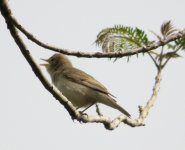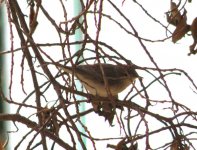PaulWWagner
New member
I saw this bird today in a park in Amman (two photos attached). It was very energetic and difficult to photograph. Lively singing, too.
My initial guess was an Eastern Olivaceous Warbler (Iduna pallida), but the undertail coverts are too long and the shape and color are off (should be paler grey-green if Olivaceous). So maybe a Reed (A. scirpaceus) or Marsh (A. palustris)? But I have no idea how to tell them apart!
If the attached images don't load, here is a URL to the photo.
My initial guess was an Eastern Olivaceous Warbler (Iduna pallida), but the undertail coverts are too long and the shape and color are off (should be paler grey-green if Olivaceous). So maybe a Reed (A. scirpaceus) or Marsh (A. palustris)? But I have no idea how to tell them apart!
If the attached images don't load, here is a URL to the photo.






